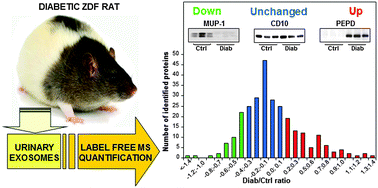Urinary exosomes and diabetic nephropathy: a proteomic approach†
Abstract
Urinary exosomes (

- This article is part of the themed collection: Molecular BioSystems 2013 Proteomics
* Corresponding authors
a
Department of Health Sciences, Milano-Bicocca University, Via Cadore 48, 20052 Monza, Italy
E-mail:
marina.pitto@unimib.it
Fax: +39 02 6448 8068
Tel: +39 02 6448 8208
b Clinica Nefrologica, San Gerardo Hospital, Univ. of Milano-Bicocca, Monza, Italy
c Department of Radiology, Oncology and Pathology Sciences, Sapienza University, Rome, Italy
d Department of Medical Biotechnology and Translational Medicine, Univ. of Milan, Italy
Urinary exosomes (

 Please wait while we load your content...
Something went wrong. Try again?
Please wait while we load your content...
Something went wrong. Try again?
F. Raimondo, S. Corbetta, L. Morosi, C. Chinello, E. Gianazza, G. Castoldi, C. Di Gioia, C. Bombardi, A. Stella, C. Battaglia, C. Bianchi, F. Magni and M. Pitto, Mol. BioSyst., 2013, 9, 1139 DOI: 10.1039/C2MB25396H
To request permission to reproduce material from this article, please go to the Copyright Clearance Center request page.
If you are an author contributing to an RSC publication, you do not need to request permission provided correct acknowledgement is given.
If you are the author of this article, you do not need to request permission to reproduce figures and diagrams provided correct acknowledgement is given. If you want to reproduce the whole article in a third-party publication (excluding your thesis/dissertation for which permission is not required) please go to the Copyright Clearance Center request page.
Read more about how to correctly acknowledge RSC content.
 Fetching data from CrossRef.
Fetching data from CrossRef.
This may take some time to load.
Loading related content
